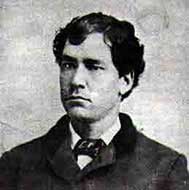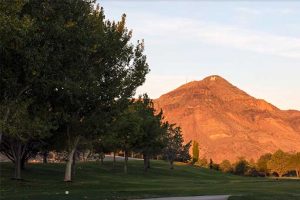Three miles down a Rocky Mountainside in the Fewest Shots
‘Watch Out for Rattlesnakes,’ a Competitor Warned Our Camera Crew
Let me tell you a little bit about the Elfego Baca Golf Shoot, the single hardest golf hole in New Mexico.
Its tee box is 7,284 feet above sea level. It plays over three miles, all of it downhill, across rocks and cactus, and it ends with a flag planted in a 50-foot dirt circle at the New Mexico Tech Golf Course, a gem of a golf course designed by one of the university’s past presidents, by the way.
The national golf media periodically rediscover the Elfego Golf Shoot. ESPN sent a guy a few years ago. Sportswriter Rick Reilly competed a couple years before that. Most recently, the event was featured in an Aug. 12 online piece by freelance writer Jeremy Fuchs for Golf.com, although this June’s event was canceled because of the Coronavirus pandemic.
Back in 2001, not long after I had left my job as a TV news producer, I pitched the Golf Channel on the Elfego Baca.
A Unique Golf Course in Socorro
The event is named for Elfego Baca, a deputy sheriff (most believe self-deputized) in Socorro County, N.M. In October 1884, Baca tried to arrest a drunken cowboy.
A shootout ensued, leaving one cowboy dead and another wounded. An angry mob formed and went to Baca’s adobe cabin, demanding that he surrender and face charges. When he refused, a mob estimated at 40-80 men laid siege and fired up to 4,000 rounds into the cabin over 33 hours.

Elfego Baca is said to have held off a siege by a mob of 40-80 people who blasted away at his adobe cabin.
Baca killed four and wounded eight. He survived largely because the floor of the cabin was slightly below ground level. At his murder trial, the door of the cabin, which had 400 bullet holes, was entered into evidence. He was acquitted.
For New Mexicans, from that day on, Elfego Baca connoted toughness. Bad-ass-ness. A tough hombre. Around the turn of the century, he moved to Albuquerque and was elected the district attorney of Bernalillo County.
The Elfego Baca was first held in 1960. It started in October as part of the week’s festivities associated with the Socorro Open. When that event ended, it was moved to June, when daily highs top 100.
The ruggedness of the terrain can’t be overstated. Every year the Elfego Baca Golf Shoot is held, first responders are on hand to cart injured people – most often news media who didn’t know what they were getting into – off the mountain.
The Golf Channel agreed to pay me to get them footage. I hired a photographer and a grip, which is someone to carry the tripod and extra tapes. Like the competitors, we were asked to sign liability releases. Shortly after first light, along with the Elfego Baca competitors, we were ferried in SUVs up the back side of “M” Mountain, the peak that towers 2,681 feet over the City of Socorro.
At the top, near the “M” formed by white-painted rocks, which stands for “Mining,” part of the official name of New Mexico Tech, is a wooden platform. It serves as the No. 1 (and only) tee box for the Elfego Golf Shoot.
The Elfego Baca Plays Downhill – Three Miles Downhill

The first tee of the Elfego Baca Golf Shoot near the top of Socorro’s M Mountain, seen from the New Mexico Tech Golf Course. (Photo: New Mexico Tech)
The rules are simple: Get down the mountain in the fewest strokes.
Each player gets a large baggie with 10 marked golf balls. The player can be assisted by up to three spotters. The spotters, many of whom wear helmets for protection against both the sun and golf balls, head downhill to about where they think their player’s shot will land, then spread out, typically in a large triangle.
The player aims at the spotters, who follow the ball in the air, then scramble across rocks, loose scree and cactus to find it. A lost ball incurs a penalty stroke. Running out of balls means a DQ.
The winner is the player who finishes with the fewest strokes made plus penalty strokes incurred (evidenced by the number of balls the player has leftin the baggie).
Elfego Baca legend and Socorro native Mike Stanley holds the record. He did it in an incredible nine strokes, for an average shot length of 586.66 yards.
Most people who complete the Elfego Baca finish at around 18 or 20 strokes. Rick Reilly shot 19. Stanley won the Elfego Baca 18 times, including the year my crew photographed it. He’s since retired, confident no one will top his win record.
After we shot the players teeing off, my crew and I hustled to keep up. “Hey, slow down, we’re trying to photograph you guys and all we’re getting is your butts and the back of your heads,” I yelled.
“Hell, no,” a player yelled back. “We’re trying to get off this damned mountain before it’s 105 degrees.” Then he laughed, “Watch out for rattlesnakes.”
In fact, we’d already been warned. About the scorpions, too, and the occasional bobcat, the cactus and the ubiquitous no-see-um gnats. We encountered everything but the bobcat.
Toughest Golf Course in New Mexico, Where Scorpions and Rattlesnakes Are in Play
You’ve probably seen highway signs warning of steep slopes expressed as a percentage, as in: “6 percent grade ahead. Trucks should use lower gears.” That’s a steep grade for a modern highway. The average grade of the Elfego Baca over its three miles is 16.41 percent.
I was 46 at the time. We all had hiking boots, thick clothing, hats and sun screen and plenty of water. The hike down was grueling, probably the hardest thing – physically – I’ve ever done.
The slope of the mountain, which is covered in loose scree, meant that for every step you made, you slid three to five yards, as if you were surfing. I thought walking downhill would be a piece of cake but my thighs quickly started knotting up. I slid, fell, slid again, sometimes collecting cactus needles on my ass, arms and hands, along with a boatload of scrapes and cuts.
My crew and I were clearly over-matched by the conditions. And these were two TV news veterans who had covered forest fires, prison riots and the like. We had a rough time keeping up with the players and their spotters.
The only times we caught up was when they had a hard time finding a ball. If the search took long enough, the player would catch up and join in. After the ball was found, he’d sit on a boulder and rest while the spotters once again headed downhill.
Then, he’d tee it up on a piece of rug, or artificial turf or on a tee stuck into the straw of a broom laid on the ground. When the spotters were in position and signaled they were ready, he’d hit. The rules of the Elfego Baca call for preferred lies, so no one is forced to hit out of a crevice.
Thanks to the altitude, the hot, thin air, the steep slope and the rocks that can send a ball ricocheting way down the hill, drives of 600-plus yards are not uncommon. My own personal record for the day, however, was more ignominious – slipping and sliding on my butt some 30 yards before I could stop.
As the event wore on, mine and my teams injuries started adding up. The grip broke a toe. The photographer sprained his wrist trying to protect the camera during a fall. My job as producer was to direct the photographer to get this shot or that shot, but we were so desperate to keep up, he shot what he could, however he could.
The Injuries Piled Up
A week after the event, I still couldn’t walk properly and I couldn’t play golf for more than a month. My thighs felt like they were on fire and the back of my neck was covered with more than a dozen dime-size, angry red welts that didn’t go away for another week.
At the bottom, after we recorded the final competitor bunting his ball into the 50-foot dirt circle with his driver, we grabbed a couple quick interviews for which we actually used the 20-pound tripod – for just the second time in the day. Then, we loaded up our gear.
After cleaning our wounds in the New Mexico Tech golf shop’s men’s room, we made a last drag-ass pass through the grille to say goodbye to this bizarre company. The beer was flowing freely and the competitors, almost all of them locals, many of them friends, and most veterans of the event, were pounding them down and getting rowdy as they washed the dust from their parched throats..
As we left, one of them yelled, “You guys hurry back now,” which was met by a burst of raucous laughter that followed us out the door. The sting of that laughter echoed in our ears as we pulled out of the parking lot and headed north toward Albuquerque, 70 miles away.
Dan Vukelich is editor of New Mexico Golf News. Reach him at dan@newmexicogolfnews.com.

